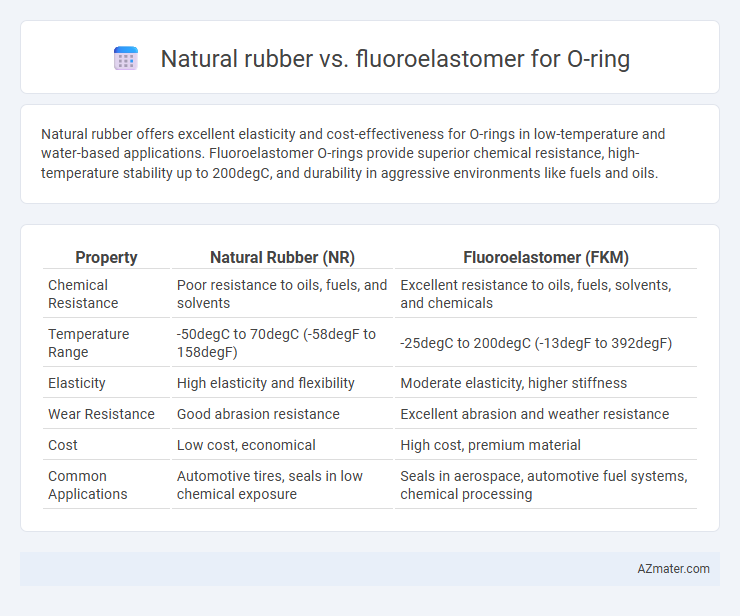Natural rubber offers excellent elasticity and cost-effectiveness for O-rings in low-temperature and water-based applications. Fluoroelastomer O-rings provide superior chemical resistance, high-temperature stability up to 200degC, and durability in aggressive environments like fuels and oils.
Table of Comparison
| Property | Natural Rubber (NR) | Fluoroelastomer (FKM) |
|---|---|---|
| Chemical Resistance | Poor resistance to oils, fuels, and solvents | Excellent resistance to oils, fuels, solvents, and chemicals |
| Temperature Range | -50degC to 70degC (-58degF to 158degF) | -25degC to 200degC (-13degF to 392degF) |
| Elasticity | High elasticity and flexibility | Moderate elasticity, higher stiffness |
| Wear Resistance | Good abrasion resistance | Excellent abrasion and weather resistance |
| Cost | Low cost, economical | High cost, premium material |
| Common Applications | Automotive tires, seals in low chemical exposure | Seals in aerospace, automotive fuel systems, chemical processing |
Introduction to O-Ring Materials
Natural rubber exhibits excellent elasticity and resilience, making it suitable for general-purpose O-rings with moderate temperature and chemical exposure. Fluoroelastomers offer superior chemical resistance, high-temperature stability up to 200degC, and excellent durability in aggressive environments, ideal for automotive and aerospace sealing applications. Selecting between natural rubber and fluoroelastomer depends on the specific operational conditions, including temperature range, chemical compatibility, and mechanical stress requirements.
Overview of Natural Rubber O-Rings
Natural rubber O-rings offer excellent elasticity, high tensile strength, and superior resistance to abrasion, making them ideal for dynamic sealing applications in automotive and industrial machinery. Their natural polymer composition provides outstanding resilience and flexibility within temperature ranges of -50degC to 70degC. However, they exhibit limited resistance to oils, chemicals, and ozone, which restricts their use in harsh environments compared to fluoroelastomer alternatives.
Properties of Fluoroelastomer (FKM) O-Rings
Fluoroelastomer (FKM) O-rings exhibit exceptional chemical resistance, particularly against oils, fuels, and aggressive solvents, making them ideal for harsh industrial environments. Their superior thermal stability allows operation at temperatures ranging from -20degC to 200degC, significantly outperforming natural rubber in high-temperature applications. FKM O-rings also offer excellent compression set resistance and low gas permeability, ensuring reliable sealing performance in demanding automotive, aerospace, and chemical processing industries.
Chemical Resistance Comparison
Natural rubber offers limited chemical resistance, performing well against water, alcohols, and some dilute acids but degrading quickly when exposed to oils, fuels, and solvents. Fluoroelastomer (FKM) provides superior chemical resistance, maintaining stability in contact with hydrocarbons, fuels, oils, and a wide range of aggressive chemicals, including acids and bases. For O-ring applications requiring exposure to harsh chemicals, fluoroelastomer is the preferred choice due to its enhanced durability and resistance to chemical degradation.
Temperature Performance Analysis
Natural rubber O-rings perform effectively within a temperature range of approximately -40degC to 70degC, exhibiting excellent elasticity and compression set resistance at lower temperatures. Fluoroelastomer O-rings, however, withstand a broader temperature spectrum from -26degC up to 205degC, offering superior thermal stability, chemical resistance, and durability in high-temperature applications. The advanced molecular structure of fluoroelastomers provides enhanced resistance to heat aging and oxidative degradation compared to natural rubber, making them ideal for demanding industrial environments.
Mechanical Strength and Durability
Natural rubber O-rings exhibit excellent elasticity and tensile strength, making them highly resistant to mechanical stress and deformation under load. Fluoroelastomer O-rings outperform natural rubber in thermal stability and chemical resistance, maintaining superior mechanical integrity and durability in harsh environments such as high temperature and exposure to oils or fuels. Despite natural rubber's good abrasion resistance, fluoroelastomers provide enhanced long-term durability and resilience in aggressive industrial applications.
Cost Differences and Economic Considerations
Natural rubber O-rings generally offer a lower initial cost compared to fluoroelastomer O-rings due to simpler manufacturing processes and abundant raw materials. Fluoroelastomer O-rings, despite higher upfront expenses, provide superior chemical resistance and longevity, reducing replacement frequency and maintenance costs over time. Economic considerations favor natural rubber for low-budget, non-demanding applications, while fluoroelastomers deliver better long-term value in harsh environments.
Typical Applications for Natural Rubber O-Rings
Natural rubber O-rings are widely used in automotive, industrial, and consumer products due to their excellent elasticity, tensile strength, and resistance to abrasion. They are typically found in applications such as sealing hydraulic systems, pneumatic devices, and household appliances where flexibility and resilience are key. These O-rings perform well in environments with temperatures ranging from -50degC to 80degC and are favored for general-purpose sealing tasks involving air, water, and mild chemicals.
Typical Applications for Fluoroelastomer O-Rings
Fluoroelastomer O-rings excel in high-temperature and chemically aggressive environments, making them ideal for automotive fuel systems, aerospace fuel and hydraulic seals, and chemical processing equipment. Their superior resistance to oils, fuels, solvents, and acids enables reliable sealing in engines, pumps, and valves where natural rubber fails due to degradation. These attributes ensure durability and leak prevention in demanding applications requiring sustained performance under extreme conditions.
Choosing the Right O-Ring Material for Your Needs
Natural rubber offers excellent elasticity, low cost, and good abrasion resistance, making it suitable for general-purpose O-rings in applications involving water, air, and mild chemicals. Fluoroelastomer (FKM) excels in high-temperature resistance, chemical inertness, and durability against fuels, oils, and aggressive chemicals, ideal for harsh environments in automotive or aerospace industries. Selecting the right O-ring material depends on factors such as temperature range, chemical compatibility, mechanical stress, and cost-efficiency tailored to your specific application requirements.

Infographic: Natural rubber vs Fluoroelastomer for O-ring
 azmater.com
azmater.com